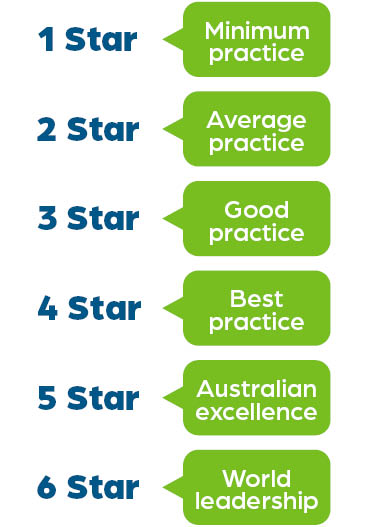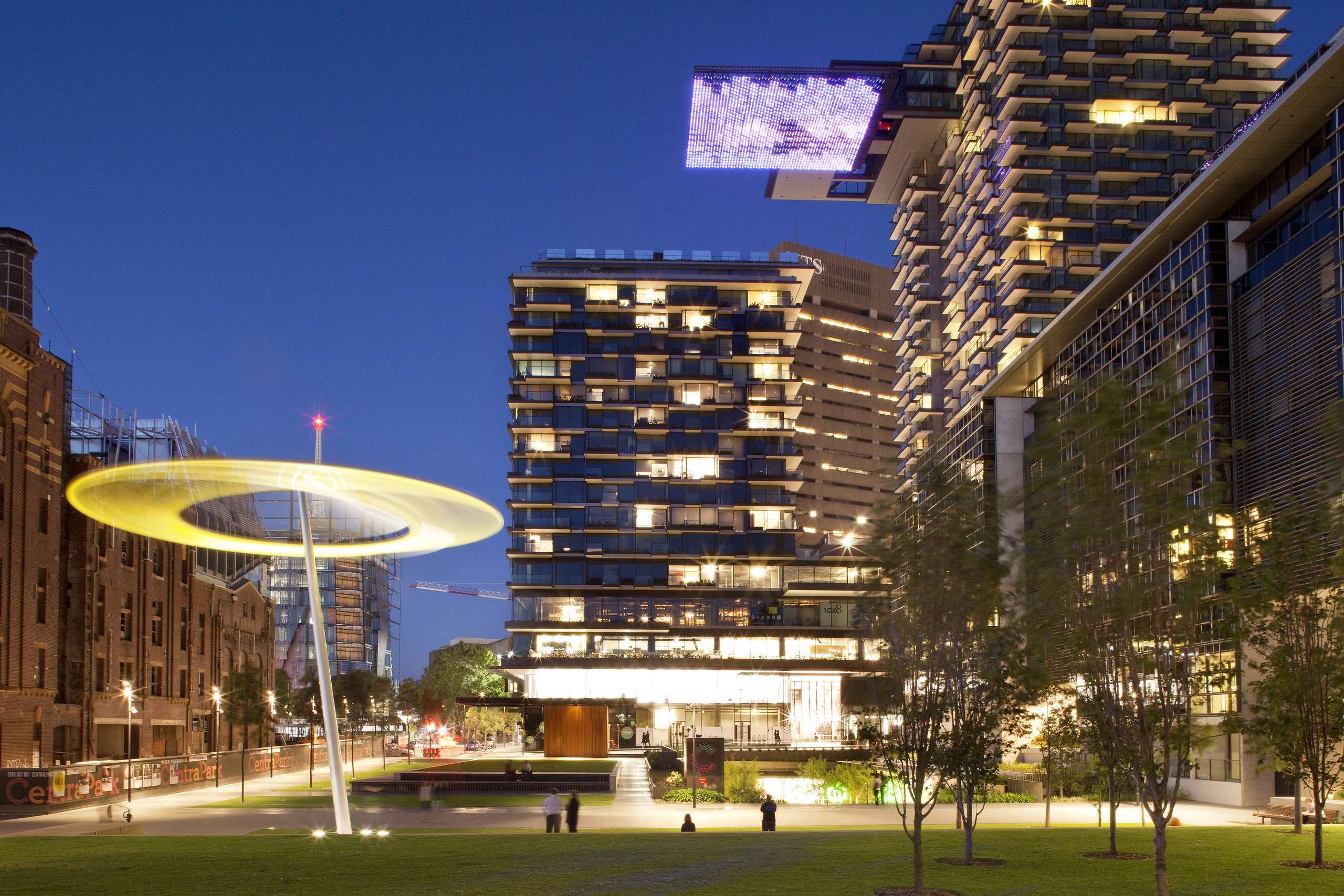What is Green Star?
Founded by Green Building Council of Australia in 2003, Green Star is an internationally recognised rating system setting the standard for healthy, resilient, positive buildings and places. Developed for the Australian environment, Green Star has certified thousands of sustainable fitouts, buildings, homes and communities right across the country with the aim of:
- Reducing the impact of climate change
- Enhancing our health and quality of life
- Restoring and protecting our planet’s biodiversity and ecosystems
- Driving resiliency in buildings, fitouts, and communities
- Contributing to market transformation and a sustainable economy
We invite you to explore Green Star by clicking on the arrows to open the menus below.
View the Green Star in focus report seriesYou’ve probably visited a Green Star certified library, retail centre, office or sport facility. You’ll also find Green Star train stations, apartment complexes and shopping centres and when you see the Green Star logo, it means you’ve arrived at a place that is good for the environment, healthy for people and ready for the future. To find a Green Star project near you, or anywhere around Australia, explore our Green Star project directory.
- 55.5 million sqm of building space is Green Star certified
- 44% of CBD office space is Green Star certified
- 40% of retail space is Green Star certified
- 1.8 million people visit a Green Star-rated shopping centre each day
- 66,500+ people will live in Green Star-rated apartments
- 800,000+ people will live or work in the 55+ Green Star communities we have certified, including 465,500+ residents and 340,000 workers and students
- 17,000+ ha of Green Star – Communities certified
- 825,000 people visit and heal in Green Star certified hospitals each year(inpatients plus 430,000 emergency/outpatients)

If you’ve set targets to mitigate climate change by transforming the built environment, you can meet them with Green Star, the Australian standard when it comes to sustainable buildings and places.
Did you know that 80 percent of Australians believe that climate action is necessary? They are asking for places that enhance wellbeing, respond to climate change, reduce emissions, and prepare for future challenges and we need to start with where we live, work, learn and play.
As a Green Star user you’ll receive:
- A roadmap to reach your social and environmental targets
- A pragmatic approach to adopting sustainability practices
- Long term economic benefits for investors, tenants, constituents and occupants
- A method to show building occupants' peace of mind that they are in a healthy environment
- A mechanism to future-proof your assets to long term regulatory change, climate change impacts, and changing trends
From office blocks, to infrastructure and apartment complexes, here’s why thousands of buildings, homes, fitouts and communities around the nation are Green Star certified:
Made for the Australian industry, by the Australian industry with foundations built on collaboration with industry and government. Each Green Star rating tool is designed, tried and tested for the Australian environment by leading sustainability and property experts.
Build for the future and demonstrate leadership with your Green Star achievements by sharing them with your industry, community, investors and tenants. Green Star certification shows your business is actively shrinking its environmental footprint and contributing to a healthier Australia for future generations. You’ll also join a movement of progressive organisations taking collective action against climate change.
Green Star certified places enjoy attractive financial and investment benefits and higher asset values; they are resilient, boast decreased operational costs, lower electricity and water usage and attract green finance mechanisms like green bonds. Certification helps you achieve Environmental Social Governance (ESG) excellence and meet the environmental and social expectations set by communities and tenants, making Green Star projects an attractive choice for investors too.
Respond to your occupants' needs and attract tenants that hang around longer. Green Star shows your commitment to holistic impacts and it plays well with others, recognising and encouraging the use of the National Australian Built environment Rating System (NABERS), WELL, Climate Active and other systems. Green Star buildings use 66 percent less energy and 51 percent less water than average buildings, savings that are both good for tenants and the environment.
Green Star is robust, user-tested and built for versatility. Whether you need to certify one project or many, Green Star’s flexibility allows you to certify a single project, several at high volume or across an existing property portfolio.
Join business from around the globe by stepping up to the climate challenge. Nations around the world are embracing the Paris Agreement, reducing carbon emissions and mitigating the impacts of climate change. Green Star helps you set goals and track progress; it is designed with reporting responsibilities in mind and recognised in local and global reporting schemes like the National Construction Code and GRESB. Green Star responds to physical and transition risks noted by the Taskforce on Climate related Financial Disclosures (TCFD) and is mindfully aligned with the UN’s Sustainable Development Goals.
Certification you can trust and an independent way to verify the environmental and social outcomes you’ve set out to achieve. Used across hundreds of projects each year, only projects that we have certified can claim to achieve a Green Star rating. Projects that claim to meet the requirements of Green Star but are not certified are potentially in breach of trademark rules and may be accused of ‘greenwash’. We operate a quality management system which complies with the requirements of ISO 9001:2015 for the development, upkeep and delivery of Green Star certification.
Green Star is versatile and can be applied to any project whether it be a new or existing building, a mixed-use precinct, a residential community, or fit-out, there’s a Green Star tool that will suit your needs:
- Green Star Buildings – covering all building types, the next iteration of Green Star will meet current and future demands on the built environment with aspirational benchmarks to address the key issues of the next decade: climate action, resource efficiency, and health and wellbeing
- Green Star Homes – launched in August 2021, Green Star Homes is a standard assessing the health, resilience and energy efficiency of the places where we live
- Green Star Interiors - transforms the interior fit-outs in everything from offices and hotels, to schools and shops
- Green Star Performance – our most popular tool boosts the operational efficiency of existing buildings
- Green Star Communities - improves the sustainability of projects at the neighbourhood, precinct or community scale
A Green Star achievement is a certification you and your stakeholders can trust. Demonstrating that your project has achieved a high standard of design, construction and/or operation, Green Star certification verifies the environmental and social outcomes you've set to achieve.
The Green Star rating system and certification process is built on a quality process accredited to ISO9001 and is developed and regularly updated in consultation with industry and government stakeholders. Achieving certification guarantees that projects are compared against the most appropriate and up-to-date benchmarks and standards available.
"Green Star ratings have become a trusted industry hallmark of quality design, effective delivery and efficient operation. The market now talks in 'stars'. It has become a trusted currency of the property sector and its customers who recognise these benefits and the future value that they represent."
- Cate Harris, Group Head of Sustainability and Lendlease Foundation
Whilst Green Star rating tool guidelines are currently available to download and use, a claim of compliance with the Green Star standard cannot be made without certification; certification is the difference between having proof that your building is green, and green washing. Projects claiming 'Green Star equivalency', have not been subjected to the independent Green Star verification process used by GBCA and NZGBC. Such claims are misleading and potentially in breach of trademark rules.
With Green Star rating tools now available for every building type, and for every stage of the building lifecycle, industry leaders are no longer choosing Green Star for 'lighthouse' projects. They are insisting on Green Star for every project.
"Green Star's final stamp of approval is unarguable - you have either built it right or you haven't. The only way to get true confirmation that you've met the Green Star benchmarks is to get a rating."
- Patrick Campbell, Operations Sustainability Manager for Building, John Holland
Green Star certification is a simple but robust online process managed by Green Building Council of Australia.
- Speak with our Market Engagement team to find the tool and approach that’s right for you
- Register your project with GBCA, the earlier you do this the easier the process will be. Once your project is registered you can share the Green Star ambitions you’re targeting with your networks
- Get familiar with our submission guidelines and the documents needed to show your project meets our benchmarks, then submit them to us using Green Star Online
- Our independent panel of sustainability experts will assess your submission, give it a score and a Green Star rating
- Green Star certification gives you the rights to use the Green Star trademark. Once you’re certified we’ll send you a certificate and marketing guide so you can share your achievement with the world!
Draw on industry expertise through our Green Star Accredited Professionals (GSAP)
